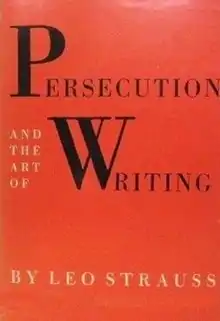
Persecution and the Art of Writing, published in 1952 by the Free Press, is a book of collected articles written by Leo Strauss.[1] The book contains five previously published essays, many of which were significantly altered by Strauss from their original publication:
- Introduction[2]
- Persecution and the Art of Writing
- The Literary Character of the Guide to the Perplexed
- The Law of Reason in the Kuzari
- How to Study Spinoza's Theologico-Political Treatise
The general theme of the book is the relationship between politics and philosophy. The thesis of the book is that many ancient and early modern political philosophers, in order to avoid persecution, hid their most heterodox ideas within their texts.
Overview
Strauss's general argument — rearticulated throughout his subsequent writings, most notably in The City and Man (1964) — is that prior to the 19th century, Western scholars commonly understood that philosophical writing is not at home in any polity, no matter how liberal. Insofar as it questions conventional wisdom, philosophy must guard itself especially against those readers who believe themselves authoritative, wise, and liberal defenders of the status quo. In questioning established opinions, or in investigating the principles of morality, pre-modern philosophers found it necessary to convey their messages obliquely. Their "art of writing" was the art of esoteric communication. This is all the more apparent in medieval times, when heterodox political thinkers wrote under the threat of the Inquisition or comparably strict tribunals.
Strauss's argument is not that medieval writers reserved one exoteric meaning for the many and an esoteric hidden meaning for the initiated few, but rather that their writings' respective core meanings extended beyond their texts' literal and/or historical dimension.
Explicitly following Gotthold Ephraim Lessing's lead,[3] Strauss indicates that medieval political philosophers, no less than their ancient counterparts, carefully adapted their written words to the dominant moral views of their time, lest their writings be condemned as heretical or unjust — not by "the many" (who did not read), but by those "few" whom the many regarded as the most righteous guardians of morality: precisely those few righteous personalities would be most inclined to persecute or ostracize anyone who is in the business of exposing the "noble lie" which supports the authority of the few over the many. Strauss thus presents Maimonides "as a closet nonbeliever obfuscating his message for political reasons."[4]
Criticism
Strauss's ideas in Persecution and the Art of Writing sparked controversy due to differing interpretations of the exoteric-esoteric dichotomy. Despite academic debate, no widely accepted interpretation of this dichotomy has emerged. Some scholars, e.g. Lampert,[5] Frazer[6] and Drury[7] believe that Strauss wrote in an esoteric manner, while, others such as Batnitzky[8] finds this idea wrong. The lack of consensus on the exoteric-esoteric dichotomy has led to conflicting interpretations of Strauss's ideas and even his character, resulting in a dispute that can be emotionally charged. For example, some view Strauss as a fascist, while others see him as a defender of democracy.[9]
In the essay, Persecution and the Art of Writing, Strauss posits that information needs to be kept secret from the masses by "writing between the lines". However, this seems like a false premise, as most authors Strauss refers to in his work lived in times when only the social elites were literate enough to understand works of philosophy.[10]
Editions
- Leo Strauss, Persecution and the Art of Writing. Glencoe, Ill.: The Free Press, 1952. Reissued Chicago: University of Chicago Press, 1988. ISBN 978-0-226-77711-5
References
- ↑ Eugene Sheppard (7 October 2014). "4". Leo Strauss and the Politics of Exile: The Making of a Political Philosopher. Brandeis University Press. ISBN 978-1-61168-769-9.
- ↑ Strauss cites the original publications in his Preface, saying, "For the Introduction I have made free use of my article 'Fārābī's Plato' ..."
- ↑ In a lecture given in 1970 at Saint John's College and entitled "A giving of account", Leo Strauss indicates that the path towards Lessing and the theme of the art of writing had been suggested to him by Jacob Klein. See "A Giving of Accounts," with Jacob Klein, The College, Vol. 22, No. 1 (April 1970), and republished in Kenneth Hart Green (ed.) : L. Strauss, Jewish Philosophy and the Crisis of Modernity. Essays and Lectures in Modern Jewish Thought, Albany, State University of New York Press, 1997.
- ↑ Michael Paley and Jacob J. Staub in Jewish Philosophy: Medieval and Modern, printed in The Schocken Guide to Jewish Books (1992) p. 215.
- ↑ Lampert, Laurence (2009-05-11), "Strauss's Recovery of Esotericism", The Cambridge Companion to Leo Strauss, Cambridge University Press, pp. 63–92, doi:10.1017/ccol9780521879026.004, ISBN 9780521879026, retrieved 2023-03-17
- ↑ Frazer, Michael L. (February 2006). "Esotericism Ancient and Modern: Strauss Contra Straussianism on the Art of Political-Philosophical Writing". Political Theory. 34 (1): 33–61. doi:10.1177/0090591705277770. ISSN 0090-5917. S2CID 154990625.
- ↑ Drury, S. B. (August 1985). "I. The Esoteric Philosophy of Leo Strauss". Political Theory. 13 (3): 315–337. doi:10.1177/0090591785013003001. ISSN 0090-5917. S2CID 143795244.
- ↑ Batnitzky, Leora (2021), "Leo Strauss", in Zalta, Edward N. (ed.), The Stanford Encyclopedia of Philosophy (Summer 2021 ed.), Metaphysics Research Lab, Stanford University, retrieved 2023-03-17
- ↑ Arnhart, Larry (June 2015). "Grant N. Havers. Leo Strauss and Anglo-American Democracy: A Conservative Critique. DeKalb: Northern Illinois University, 2013. Pp. xi+245. $37.00". American Political Thought. 4 (3): 513–516. doi:10.1086/682033. ISSN 2161-1580.
- ↑ Bekesi, Aron B (2019-12-31). "Esoteric philosophy: Leo Strauss and sociolinguistics". Science & Philosophy. 7 (2). doi:10.23756/sp.v7i2.481.
Further reading
- Leo Strauss, Lecture Notes for 'Persecution and the Art of Writing'. Critical edition by Hannes Kerber. Published in Yaffe/Ruderman (ed.): Reorientation: Leo Strauss in the 1930s. New York, NY.: Palgrave Macmillan, 2014, pp. 293–304.